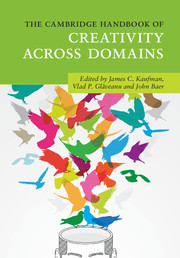Book contents
- The Cambridge Handbook of Creativity Across Domains
- The Cambridge Handbook of Creativity Across Domains
- Copyright page
- Dedication
- Contents
- Figures
- Tables
- Contributors
- Acknowledgments
- Part I Creativity and Domain
- Part II Creativity in the Traditional Arts
- Part III Creativity in the Sciences
- Part IV Creativity in Business
- 18 Studying Creativity across Different Domains
- 19 The Relationship Between Marketing and Creativity
- 20 Creative Leadership
- 21 Creativity in Business and Technology
- 22 Creativity in Design
- 23 A Minimalist Model for Measuring Entrepreneurial Creativity
- Part V Newer Domains for Creativity Research
- Part VI Creativity in Everyday Life
- Part VII Conclusion
- Index
- References
18 - Studying Creativity across Different Domains
Advertising
from Part IV - Creativity in Business
Published online by Cambridge University Press: 15 September 2017
- The Cambridge Handbook of Creativity Across Domains
- The Cambridge Handbook of Creativity Across Domains
- Copyright page
- Dedication
- Contents
- Figures
- Tables
- Contributors
- Acknowledgments
- Part I Creativity and Domain
- Part II Creativity in the Traditional Arts
- Part III Creativity in the Sciences
- Part IV Creativity in Business
- 18 Studying Creativity across Different Domains
- 19 The Relationship Between Marketing and Creativity
- 20 Creative Leadership
- 21 Creativity in Business and Technology
- 22 Creativity in Design
- 23 A Minimalist Model for Measuring Entrepreneurial Creativity
- Part V Newer Domains for Creativity Research
- Part VI Creativity in Everyday Life
- Part VII Conclusion
- Index
- References
Summary
Creativity is the heart of advertising. The advertising industry provides a unique research setting with a range of highly specialized roles. These roles range from undertaking creative ideation processes through to idea refinement and expression, evaluation, and relationship management roles. Like all creative ideas, great creativity in advertising requires ideas that are both original and appropriate, but also well presented. Numerous constraints exist to achieving great creative advertising including time, medium, and evaluation pressures. Evaluative pressures result from the difficulty in accurately assessing the effects of an advertising campaign prior to vast expenditures being made. This increases the potential for conflict and the need for structures and processes to be established to manage relationships. For the privileged few who have been fortunate to research in this industry, their insights have assisted our understanding of a range of complex interactions and constraints that influence the full range of creative processes and outcomes. While this research has provided many practical findings, there is still much to learn from this dynamic field.
- Type
- Chapter
- Information
- The Cambridge Handbook of Creativity across Domains , pp. 325 - 344Publisher: Cambridge University PressPrint publication year: 2017



